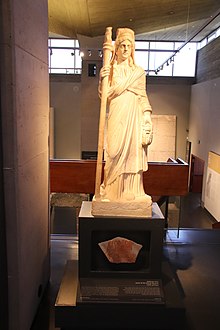
Back بروسربينا Arabic بروسربينا ARZ Прозерпина Bashkir Празерпіна Byelorussian Прозерпина Bulgarian Proserpina Breton Prozerpina BS Prosèrpina Catalan Pruserpina Corsican Proserpina Danish
| Proserpina | |
|---|---|
Queen of the Underworld, goddess of female and agricultural fertility, and springtime growth | |
 Marble statue of Proserpina, 2nd century AD. She is depicted holding a torch lighting her way and a sheaf of grain symbolizing abundance. | |
| Abode | Orcus, in winter (Roman name for underworld, and for its ruling deity, equivalent to Greek Hades) |
| Symbol | torch, sheaf, pomegranate |
| Temples | Aventine Hill (with Liber and Ceres) |
| Festivals | Liberalia (uncertain) |
| Personal information | |
| Parents | Ceres |
| Siblings | Liber (various traditions) |
| Consort | Liber, Dis Pater or Orcus (various traditions) |
| Equivalents | |
| Greek equivalent | Persephone, Ariadne |
Proserpina (/proʊˈsɜːrpɪnə/ proh-SUR-pih-nə;[1] Latin: [proːˈsɛrpɪna]) or Proserpine (/ˈprɒsərpaɪn/ PROSS-ər-pyne[1]) is an ancient Roman goddess whose iconography, functions and myths are virtually identical to those of Greek Persephone. Proserpina replaced or was combined with the ancient Roman fertility goddess Libera, whose principal cult was housed in the Aventine temple of the grain-goddess Ceres, along with the wine god Liber.
Each of these three deities occupied their own cella at the temple. Their cults were served or supervised by a male public priesthood. Ceres was by far the senior of the three, one of the dii consentes, Rome's approximate equivalent to the Greek Twelve Olympians. She was identified with Greek Demeter and Liber was identified with Bacchus and Dionysus. Libera is sometimes described as a female version of Liber Pater, concerned with female fertility. Otherwise she is given no clear identity or mythology by Roman sources, and no Greek equivalent. Nothing is known of her native iconography: her name translates as a feminine form of Liber, "the free one". Proserpina's name is a Latinisation of "Persephone", perhaps influenced by the Latin proserpere ("to emerge, to creep forth"), with reference to the growing of grain.
Proserpina was imported from southern Italy as part of an official religious strategy, towards the end of the second Punic war, when antagonism between Rome's lower and upper social classes, crop failures and intermittent famine were thought to be signs of divine wrath, provoked by Roman impiety. The new cult was installed around 205 BC at Ceres' Aventine temple. Ethnically Greek priestesses were recruited to serve Ceres and Proserpina as "Mother and Maiden". This innovation might represent an attempt by Rome's ruling class to please the gods and the plebs; the latter shared strong cultural ties with Italian magna Graeca. The reformed cult was based on the Greek, women-only Thesmophoria, and was promoted as morally desirable for respectable Roman women, both as followers and priestesses. It was almost certainly supervised by Rome's Flamen Cerealis, a male priesthood usually reserved to plebeians. The new cult might have partly subsumed the Aventine temple's older, native cults to Ceres, Liber and Libera, but it also functioned alongside them. Liber played no part in the reformed cult. Ceres, Proserpina/Libera and Liber are known to have received cult in their own right, at their Aventine temple and elsewhere, though details are lacking.
The Roman cult of Mother and Maiden named Proserpina as queen of the underworld, spouse to Rome's king of the underworld, Dis pater, and daughter to Ceres. The cult's functions, framework of myths and roles involved the agricultural cycle, seasonal death and rebirth, dutiful daughterhood and motherly care. They included secret initiations and nocturnal torchlit processions, and cult objects concealed from non-initiates. Proserpina's forcible abduction by the god of the underworld, her mother's search for her, and her eventual but temporary restoration to the world above are the subject of works in Roman and later art and literature. In particular, her seizure by the god of the Underworld – usually described as the Rape of Proserpina, or of Persephone – has offered dramatic subject matter for Renaissance and later sculptors and painters.
- ^ a b "Proserpina". American English Dictionary. HarperCollins. Retrieved 15 July 2013.
© MMXXIII Rich X Search. We shall prevail. All rights reserved. Rich X Search